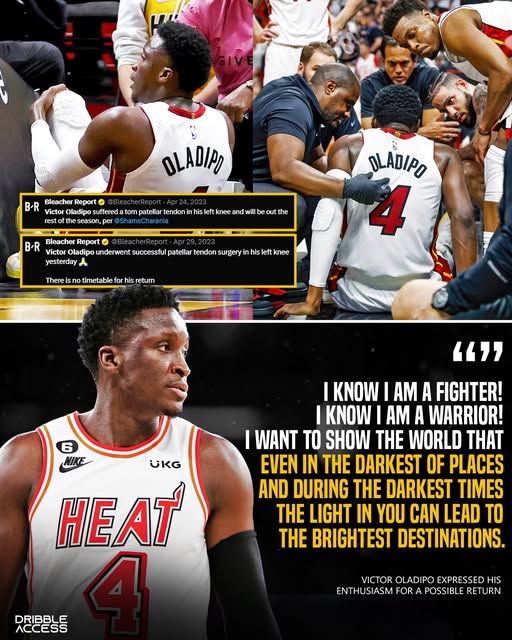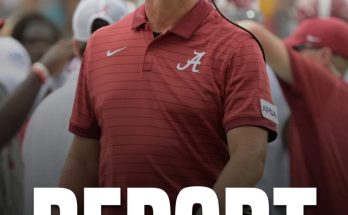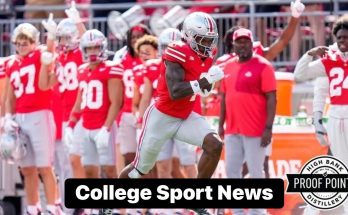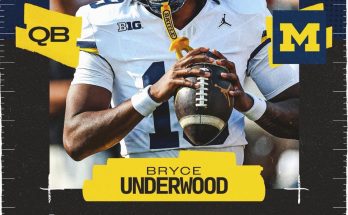Victor Oladipo’s journey through the NBA is nothing short of remarkable, and now, in 2025, he stands on the brink of yet another potential return to the court. It’s a narrative that has become all too familiar to fans and insiders alike—one that blends promise, perseverance, and a relentless fight against adversity. After tearing his left patellar tendon during a playoff game against the Milwaukee Bucks in 2023 while playing for the Miami Heat, Oladipo hasn’t played in an NBA game since. Yet as NBA teams finalize their depth charts for the upcoming season, whispers around the league have begun to grow louder: Victor Oladipo might just find his way back onto an NBA roster.
To appreciate the significance of these developments, it’s important to revisit Oladipo’s journey. Coming out of Indiana University as a standout guard, he was selected second overall by the Orlando Magic in the 2013 NBA Draft. From his early years, he was touted not just for his elite athleticism, but for his work ethic, defensive tenacity, and explosive scoring ability. Over time, he established himself as one of the league’s top two-way guards, peaking during the 2017-2018 season with the Indiana Pacers. That year, Oladipo earned his first All-Star selection and was named to the All-NBA Third Team and NBA All-Defensive First Team. He led the league in steals and seemed poised to be a cornerstone player for years to come.
However, fate had a different plan. Injuries began to derail his ascent. In January 2019, Oladipo suffered a ruptured quad tendon in his right knee—a devastating injury that sidelined him for over a year. His return in 2020 was met with caution and lowered expectations. He was eventually traded from the Pacers to the Houston Rockets as part of the James Harden deal, and then moved again to the Miami Heat. Though he showed flashes of his former self, he was never quite able to string together the consistent high-level performances that had once defined his game. And just when it seemed like he was finding a rhythm in Miami’s rotation, another major setback occurred: the patellar tendon tear in 2023.
The patellar tendon, connecting the kneecap to the shinbone, is critical for explosive movement—jumping, sprinting, and lateral motion. For a player like Oladipo, whose game relies heavily on agility, quick first steps, and verticality, such an injury is more than just physically debilitating—it challenges every facet of their identity on the court. The rehabilitation process is long, grueling, and mentally taxing. For many athletes, it becomes the defining battle of their career.
Now, two years removed from his last NBA appearance, Oladipo finds himself at a crossroads. He’s not the high-flying All-Star he once was, at least not in the eyes of teams looking to invest heavily in their backcourt. But he still carries something invaluable: experience, a high basketball IQ, and the resilience that only those who have walked through fire possess. These attributes, coupled with a clean bill of health, could make him an attractive low-risk, high-reward addition for a contending team looking to solidify its bench or add veteran presence in the locker room.
The growing speculation about Oladipo’s return isn’t just idle chatter. Front offices around the league are keenly aware of the importance of depth. In today’s NBA, where load management, injuries, and long postseason runs put tremendous strain on rosters, having capable, seasoned players ready to contribute is a vital asset. Consider the impact of veterans like Jeff Green, Derrick Rose, and Rajon Rondo in recent playoff campaigns—not necessarily stars, but players who understand moments, systems, and how to make smart plays under pressure.
Oladipo fits into that mold, albeit with a higher ceiling if his body holds up. Even if he never returns to 20-points-per-game form, he has the tools to become a valuable rotational piece. He’s a capable ball-handler, a committed defender who can guard multiple positions, and someone who understands the grind of the playoffs. With the right medical support and minutes management, he could flourish in a specific role—perhaps as a second-unit stabilizer or defensive specialist.
Training footage from the offseason suggests that Oladipo has been steadily ramping up his activity. Those close to his camp report that he’s been training diligently, emphasizing strength conditioning, balance, and movement mechanics. While teams remain cautious—understandably so given his injury history—there’s a sense that someone will extend an invitation to training camp, especially as injuries inevitably pop up during preseason activities and gaps in rosters become apparent.
Oladipo’s potential return also opens up broader conversations about the nature of athletic recovery, career longevity, and the evolving role of veterans in the NBA. Over the past decade, advancements in sports medicine, nutrition, and physical therapy have extended the careers of many athletes who, in earlier eras, might have faded from the league prematurely. Kevin Durant’s return from an Achilles tear and Klay Thompson’s recovery from back-to-back ACL and Achilles injuries are prime examples of what modern rehabilitation can achieve when paired with unwavering determination.
Still, it’s important not to romanticize the comeback too much. The odds are steep. Even if Oladipo is physically cleared, regaining in-game rhythm and timing after such a prolonged absence is immensely challenging. NBA defenses are faster, offenses are more complex, and the talent pool is deeper than ever. Younger players are constantly emerging, and front offices are often more inclined to invest in developing potential than in banking on uncertain returns from veterans with medical histories.
That said, there’s an intangible value Oladipo brings that’s harder to quantify: leadership through adversity. Teammates consistently describe him as a vocal leader, someone who brings positive energy and mentorship to the locker room. He’s played under multiple systems, alongside a variety of stars, and in high-stakes games. For a young team trying to build culture or a contender looking for stability in its second unit, these qualities can make a tangible difference.
If he does make it back onto a roster, his role will likely look very different than it did during his peak. Rather than being a primary scoring option or franchise centerpiece, Oladipo may be asked to anchor a bench unit, guard opposing wings, or facilitate offense in short stretches. This requires a mental shift—a transition from star to contributor. Many players struggle with this evolution, but Oladipo’s maturity and self-awareness suggest he may be uniquely equipped to handle it.
From a financial standpoint, the terms of any deal would likely be modest. Minimum contracts, non-guaranteed training camp invites, or two-way possibilities are the most realistic starting points. But sometimes, that’s all a player needs—a foot back in the door, a chance to prove they can still play. Oladipo’s best path may come through an organization with a strong developmental program, one that can afford to be patient and support his gradual return to form.
Speculation points to several teams who might be a fit. The Miami Heat, his last NBA team, are known for their belief in hard-working veterans and their elite conditioning program. A reunion is not out of the question, particularly if injuries open up a roster spot. The Los Angeles Lakers, with a history of adding experienced guards and managing minutes strategically, could also be a landing spot. Other potential fits include the Golden State Warriors, Milwaukee Bucks, and Phoenix Suns—all teams with championship aspirations that value two-way guards who can contribute situationally.
The public’s response to a potential Oladipo return has been overwhelmingly supportive. Fans who have followed his career—from his days at Indiana University, through his All-Star years, to the devastating injuries—see in him a symbol of persistence. In a sports culture that often focuses solely on wins, stats, and accolades, Oladipo’s story is a reminder of the human side of competition: the pain of setbacks, the quiet work of rehabilitation, and the strength it takes to start over, again and again.
And perhaps that’s what makes the idea of his comeback so compelling. It’s not about chasing fame or proving doubters wrong. It’s about reclaiming joy. For Oladipo, basketball has never been just a job—it’s a passion, a purpose, a calling. Every minute he fights to get back on the court is a testament to that love. In a league filled with young stars and emerging talent, there’s still room for those whose most valuable asset is heart.
Ultimately, whether or not Victor Oladipo makes an official return this season, his presence in the conversation speaks volumes. He’s no longer just the player defined by All-Star accolades or explosive scoring. He’s become something richer: a figure of perseverance in the face of overwhelming adversity. His journey invites reflection on the nature of resilience, the unpredictability of athletic careers, and the ever-evolving definition of success.
Oladipo’s story isn’t over yet. It might not have the cinematic ending of a championship or another All-Star nod. But it has meaning, depth, and inspiration. And for every young player recovering from an injury, every athlete wondering if they can ever get back to where they once were, Oladipo’s determination offers hope.
In the coming weeks, as rosters crystallize and preseason matchups begin, keep an eye on training camp invites and late-offseason signings. Because somewhere in a quiet gym, away from the spotlight, Victor Oladipo is still working. Still chasing. Still believing. And sometimes, belief is the first step to making the impossible possible.



